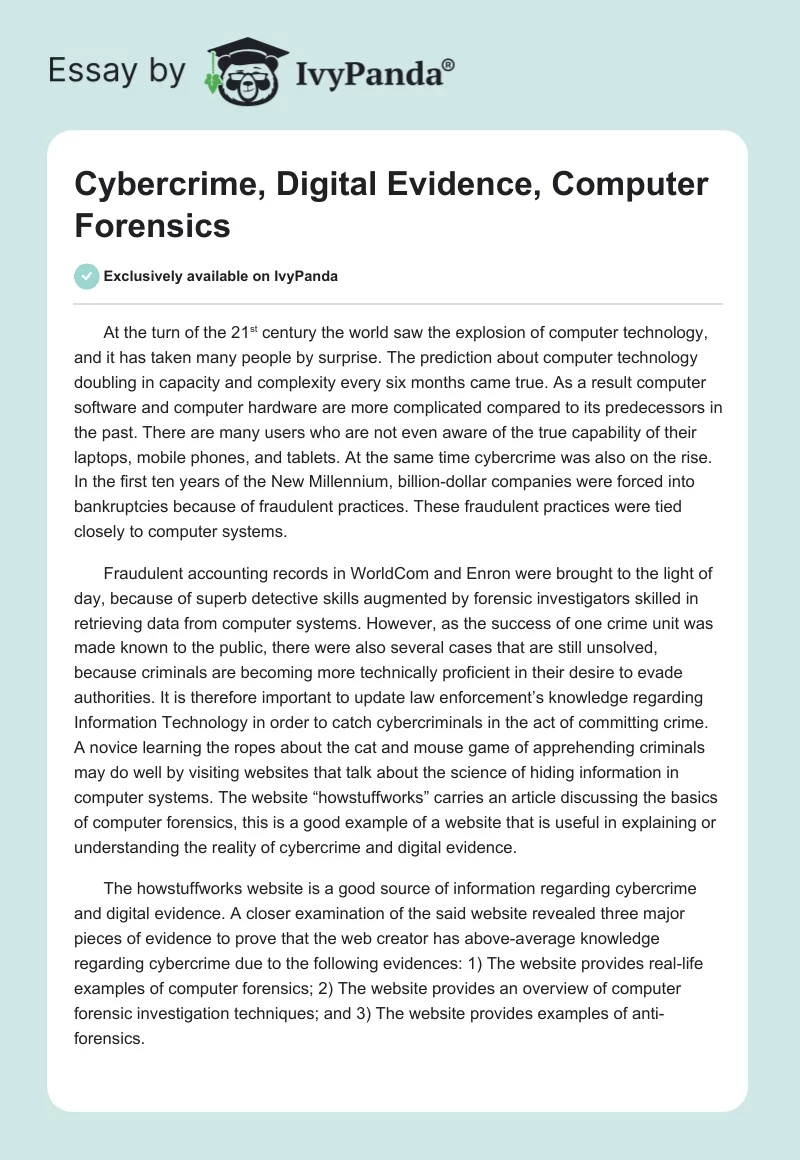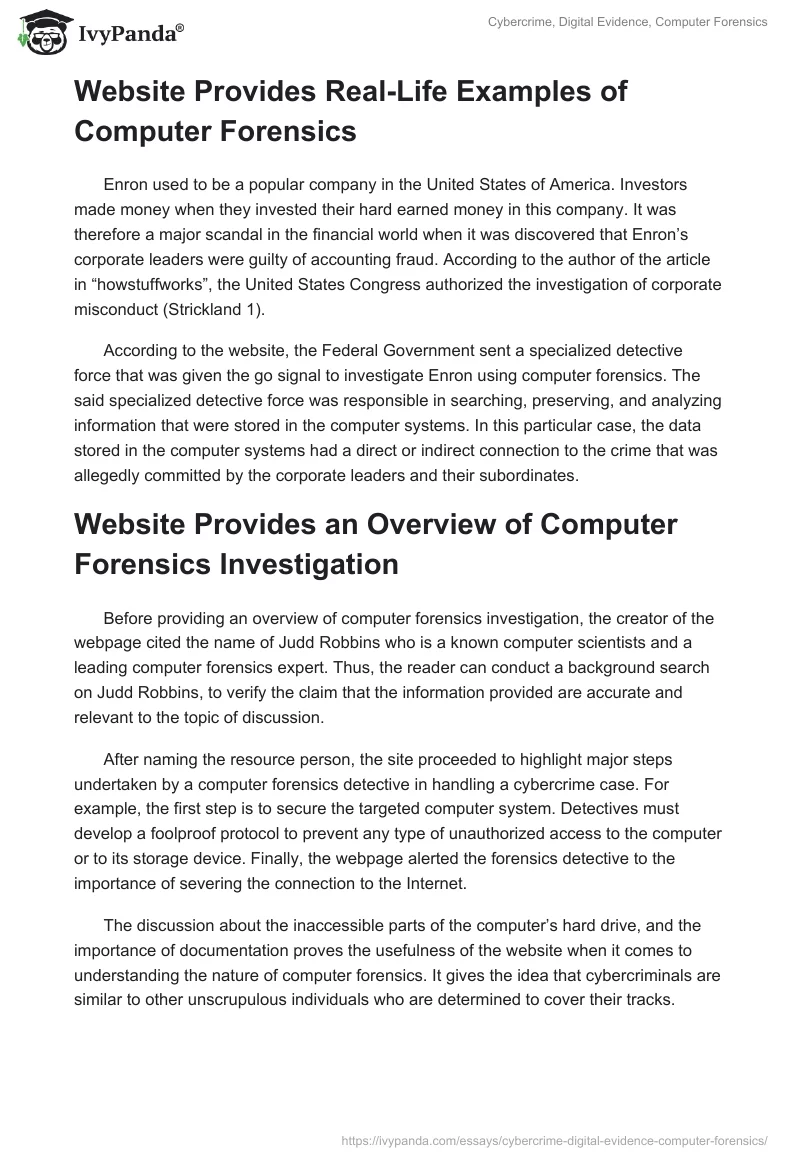At the turn of the 21st century the world saw the explosion of computer technology, and it has taken many people by surprise. The prediction about computer technology doubling in capacity and complexity every six months came true. As a result computer software and computer hardware are more complicated compared to its predecessors in the past. There are many users who are not even aware of the true capability of their laptops, mobile phones, and tablets. At the same time cybercrime was also on the rise. In the first ten years of the New Millennium, billion-dollar companies were forced into bankruptcies because of fraudulent practices. These fraudulent practices were tied closely to computer systems.
Fraudulent accounting records in WorldCom and Enron were brought to the light of day, because of superb detective skills augmented by forensic investigators skilled in retrieving data from computer systems. However, as the success of one crime unit was made known to the public, there were also several cases that are still unsolved, because criminals are becoming more technically proficient in their desire to evade authorities. It is therefore important to update law enforcement’s knowledge regarding Information Technology in order to catch cybercriminals in the act of committing crime. A novice learning the ropes about the cat and mouse game of apprehending criminals may do well by visiting websites that talk about the science of hiding information in computer systems. The website “howstuffworks” carries an article discussing the basics of computer forensics, this is a good example of a website that is useful in explaining or understanding the reality of cybercrime and digital evidence.
The howstuffworks website is a good source of information regarding cybercrime and digital evidence. A closer examination of the said website revealed three major pieces of evidence to prove that the web creator has above-average knowledge regarding cybercrime due to the following evidences: 1) The website provides real-life examples of computer forensics; 2) The website provides an overview of computer forensic investigation techniques; and 3) The website provides examples of anti-forensics.
Website Provides Real-Life Examples of Computer Forensics
Enron used to be a popular company in the United States of America. Investors made money when they invested their hard earned money in this company. It was therefore a major scandal in the financial world when it was discovered that Enron’s corporate leaders were guilty of accounting fraud. According to the author of the article in “howstuffworks”, the United States Congress authorized the investigation of corporate misconduct (Strickland 1).
According to the website, the Federal Government sent a specialized detective force that was given the go signal to investigate Enron using computer forensics. The said specialized detective force was responsible in searching, preserving, and analyzing information that were stored in the computer systems. In this particular case, the data stored in the computer systems had a direct or indirect connection to the crime that was allegedly committed by the corporate leaders and their subordinates.
Website Provides an Overview of Computer Forensics Investigation
Before providing an overview of computer forensics investigation, the creator of the webpage cited the name of Judd Robbins who is a known computer scientists and a leading computer forensics expert. Thus, the reader can conduct a background search on Judd Robbins, to verify the claim that the information provided are accurate and relevant to the topic of discussion.
After naming the resource person, the site proceeded to highlight major steps undertaken by a computer forensics detective in handling a cybercrime case. For example, the first step is to secure the targeted computer system. Detectives must develop a foolproof protocol to prevent any type of unauthorized access to the computer or to its storage device. Finally, the webpage alerted the forensics detective to the importance of severing the connection to the Internet.
The discussion about the inaccessible parts of the computer’s hard drive, and the importance of documentation proves the usefulness of the website when it comes to understanding the nature of computer forensics. It gives the idea that cybercriminals are similar to other unscrupulous individuals who are determined to cover their tracks.
Website Provides Examples of Anti-Forensics
The best proof that the webpage creator had an in-depth understanding of computer forensics can be seen in the discussion on how to defeat the specialized detective force that was sent to detect cybercrime. The website talks about how to conceal data by dividing it into smaller sections. The next step was to conceal the smaller sections at the tail end of other files. According to the website, most data files have an unused portion that are named “slack space” (Strickland 4).
It is an eye-opening revelation for those who are new to the cybercrime game. At the same time, it is a useful piece of information for cybercrime detectives who are trying their best to extract all relevant information within a computer system. Not all the files that are inside a computer system are relevant pieces of evidences needed to build a case. Therefore, it is a challenge for investigators to navigate through a virtual world of computer files. They are reliant on specific computer software to help them understand where files are hidden. However, a skilled cybercriminal knows the weakness of law enforcement tools that were created to track all relevant files needed to convict the guilty party.
The website also pointed out that aside from using the “slack space”, cybercriminals are also prone to hide files inside executable files. In a normal file retrieval process, the software detection program skips over the executable files, because these are files needed to install software. But clever cybercriminals have found a way to hide files into executable files using programs called packers.
Conclusion
The website “howstuffworks” has created an article that is helpful for those who want to learn more about computer forensics. It is an excellent source of information because of three major reasons: 1) The website provides real-life examples of computer forensics; 2) The website provides an overview of computer forensic investigation techniques; and 3) The website provides examples of anti-forensics. The website contains information that is not commonly found in other sites. It provides basic information on what a detective needs to do in order to increase the probability of success when building a case against a cybercriminal. On the other hand, this website is accessible to the public. Therefore, it is not accurate to say that it serves a public service when it comes to defeating cybercrime. In fact, cybercriminals can use the information in the said website to improve their skills when it comes to hiding critical files.
Works Cited
Strickland, Jonathan. How Computer Forensics Works. howstuffworks, 2014. Web.


